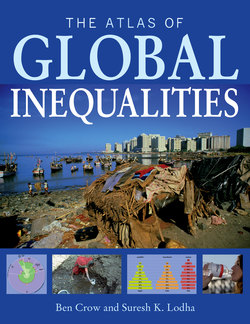Читать книгу The Atlas of Global Inequalities - Ben Crow - Страница 6
На сайте Литреса книга снята с продажи.
ОглавлениеClass 44 Class divisions separate the rich and powerful from those who have little opportunity to gain wealth and influence. Race & Ethnicity 46 Some minority ethnic and religious groups suffer systematic discrimination. Inequalities associated with ethnicity are frequently intertwined with those of gender and poverty. Child Labor 48 Millions of children are employed in paid or household work. Raising wages and reducing poverty is the most effective way of reducing child labor. 4 Inequalities of Access 50 Poverty 52 Poverty remains widespread, but recent studies suggest new avenues for action. Hunger 54 Hunger, is one of the most devastating dimensions of inequality. Children are particularly at risk from its effects. Household Water 56 Poor people and those living in rural areas are least likely to have easy access to safe drinking water. Energy 58 Energy is a prerequisite for economic opportunities and human development that remains inaccessible to many due to poverty, rural location, or lack of infrastructure. Household Fuel 60 Most people in developing countries have access only to biomass and solid fuels for household use. These fuels pose serious health hazards. Mobility 62 The opportunity to travel easily and safely even for short distances is a key indicator of both economic and gender inequality. Digital Divide 64 The digital divide between industrialized and non-industrialized countries constrains the advance of healthcare, education, social freedoms, and livelihoods. 5 Health Inequalities 66 Life Expectancy 68 Societies with higher GDP tend to have higher life expectancy. Societies with greater equality achieve longer life spans than more unequal societies. Maternal Mortality 70 The half a million women who die each year from complications related to pregnancy are mainly from the poorest people in the least developed countries. Child Mortality 72 Children in developing countries become sick and often die of preventable or treatable diseases. Access to Healthcare 74 Access to healthcare is worst in low-income countries, in rural areas and for the poor. The rich benefit most from government health expenditure. Infectious Diseases 76 Malaria, HIV/AIDS, and tuberculosis have a devastating effect on the poorest and most vulnerable people in developing countries.
